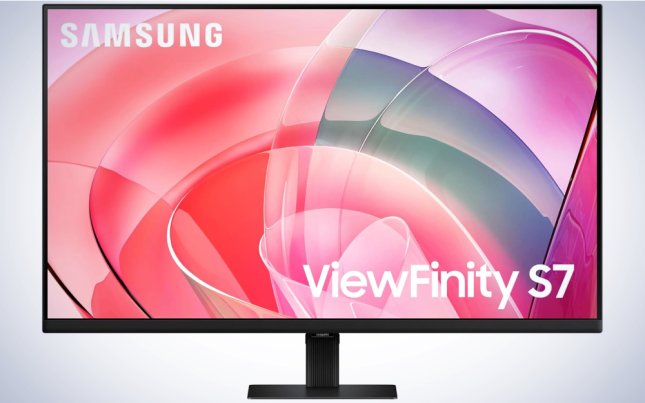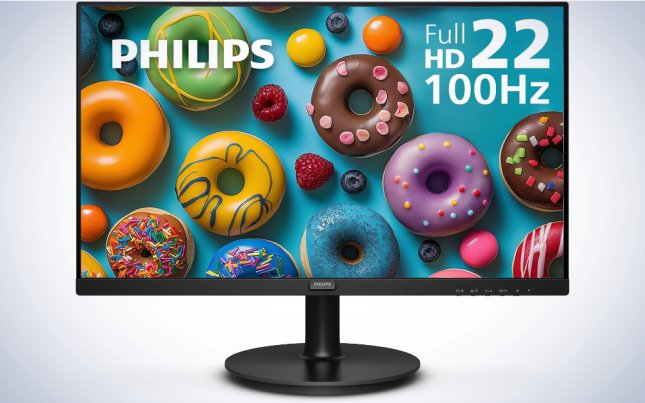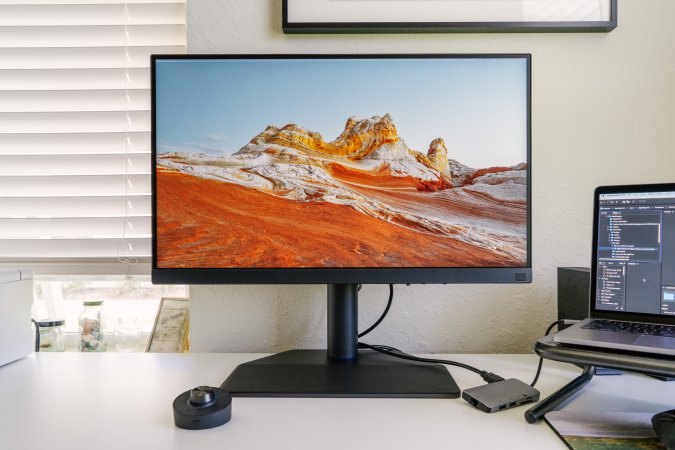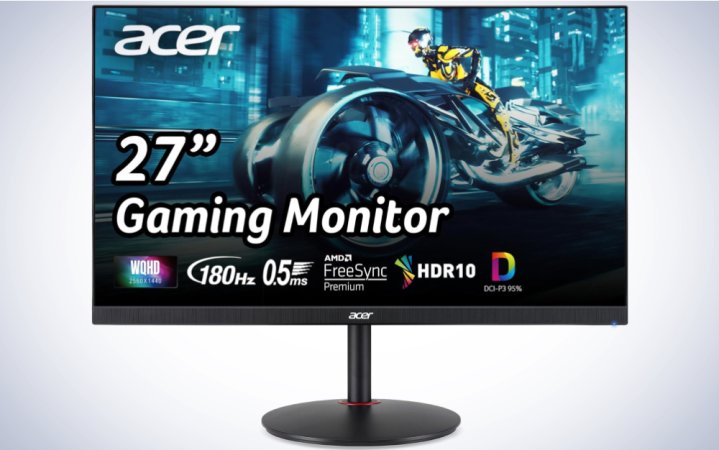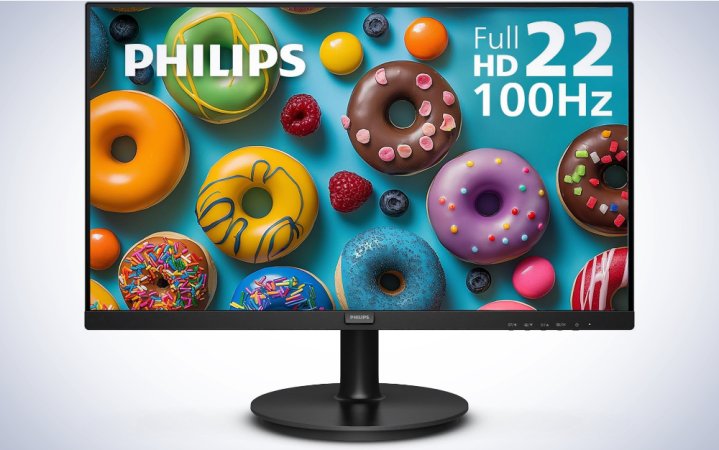We may earn revenue from the products available on this page and participate in affiliate programs. Learn more ›
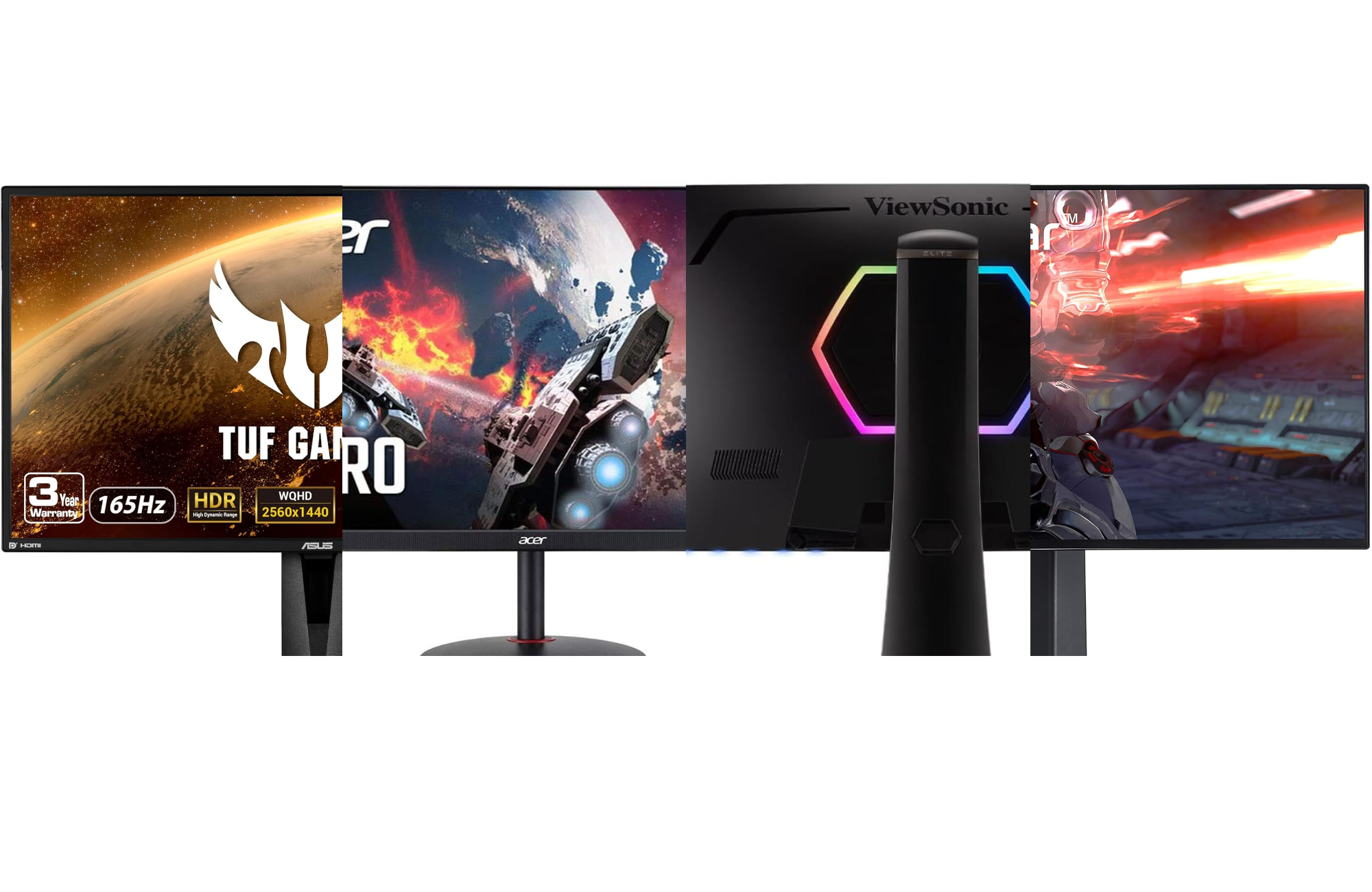
If you’re trading frequently, you know that monitors for trading are the ones that let your mind directly enter the screen, not just notice what’s ticking across it. They don’t distract you as you dive headfirst into the world of crypto, dividends, or corporate mergers. With West Coast stock trading hours opening at 6:30 a.m. and crypto being a 24-hour scramble for the best, there are a lot of environmental conditions to consider. While we like BenQ SW272U the most, different displays are designed to excel in certain scenarios. So, what peripherals can bring you the best in terms of eye health, easy reading, and financial gain? We’ve delved into what’s available and found the best monitors for trading, no matter your purpose or needs.
- Best overall: BenQ SW272U
- Best for stock trading: Acer Nitro XV271U
- Best for crypto trading: Samsung ViewFinity S70D
- Best for day trading: Samsung ViewFinity S50GC
- Best budget: Philips 221V8LB
How we chose the best monitors for trading
We combined personal experience, peer input, respected critics, and user impressions to compile our list. We also considered the environment of the modern work-from-home trader and what they needed. The reality is that there is a lot of diversity in these needs. For example, stock traders are most likely to complain about morning light due to the early nature of market openings. On the other hand, the day trader needs to assess information rapidly with the most readable and information-dense screen possible.
To make the cut, each monitor had to fit the profile of individual user types. Questions were asked that took us into an individual trader’s point of view: What are the potential pain points of this trader, what lighting will this person’s monitor most likely need, etc.? Along with those questions, the following are things we believe you should keep in mind before buying monitors for trading:
The best monitors for trading: Reviews & Recommendations
We have quite a selection of monitors across quite a range of prices and styles. Ultimately, all of them are top-of-the-line modern monitors that can be used for all daily purposes. Still, some monitors perform just slightly better at certain times of day and give your eyes that extra bit of comfort you desire:
Best overall: BenQ SW272U
Pros
- Matte finish results in zero reflections or glare
- Ergonomic stand allows for vertical or horizontal orientation
- Minimal bezel and 27-inch size provide plenty of screen real estate
- Offers HDMI, DisplayPort, or USB-C connectivity
Cons
- Expensive
- Photography-specific features may not be needed for most
Why it made the cut: This BenQ monitor offers a reflection-free finish, a large display with minimal bezels, and a hotkey puck for quick settings adjustments.
Specs
- Resolution: 4K
- Screen surface: Anti-glare matte
- Refresh rate: 60 Hz
- Size: 27 inches
The BenQ SW272U is a fantastic, well-rounded monitor rich in features and high-end specs. The large 27-inch screen size and the minimal bezel design give you plenty of room for seeing all the details of your trades. The 4K resolution means that text will be sharp, clear, and easy to read.
BenQ built this monitor with a Fine-Coated anti-reflection panel. This results in essentially zero glare or reflections, so your focus can remain on the important stuff. And should you want even fewer distractions, it comes with an easy-to-install hood. The included monitor stand features an attractive leatherette base for organizing your desk. It can be turned 90 degrees if you prefer vertical orientation. And the height, tilt, and swivel are also adjustable to fully fine-tune your setup.
The SW272U offers two HDMI 2.0 ports and a DisplayPort 1.4 input. Additionally, you can transfer data to your laptop using the USB-C connector. And the two-port USB-A 3.1 Gen 1 hub and built-in SD card reader add convenience. The monitor also comes with BenQ’s Hotkey Puck G3, which makes adjusting settings even more convenient.
BenQ designed this monitor for photographers and video editors. As a result, it offers lots of photography-specific features, such as highly accurate colors, Paper Color Sync for accurate print results, and P3 color space for accurate video work. If you plan on using the monitor strictly for trading, you may be paying for unnecessary features. But it’s an extremely high-quality and versatile monitor for those who want the best.
Best for stock trading: Acer Nitro XV271U
Pros
- Large screen size
- VESA compatible
- Height adjustable with 360-degree swivel
Cons
- May be too large for your desk
Why it made the cut: This Dell is an anti-glare, flicker-free monitor that goes beyond just getting the job done.
Specs
- Resolution: 1440p
- Screen Surface: Anti-Glare
- Size: 27”
Acer’s Nitro XV271U is an excellent display for the days when you’d like to head directly from bed to your computer for stock trading. Its ultra-high refresh rate of 180Hz will allow you to see changes in the prices of your shares immediately, with absolutely no display. It’s VESA-compatible, which means you’ll be able to mount it to an arm to position it perfectly within your line of sight.
Two other key features of this monitor helpful for stock trading are its large size and relatively high resolution. This will allow you to comfortably keep multiple windows open and accessible simultaneously, which can be helpful if you’re reading up on a potential investment on a news site while queuing up a purchase page on another. A similar scenario is having two pages–each with information on a different stock—so you can assess them to decide which would be the better investment.
Having said that, a 27-inch monitor does require a lot of desk space, which you may not have to spare. If that’s the case, we have many recommendations that fall into the 22-inch or smaller range, which could be a better choice.
Best for crypto trading: Samsung ViewFinity S70D
Pros
- Huge display
- Very high resolution
- Eye Care mode
Cons
- May be too large for your desk
Why it made the cut: It provides a fantastic low-blue mode for those crazy trading nights.
Specs
- Resolution: 4K
- Refresh Rate: 60 Hz
- Size: 32”
If you have enough space on your personal trading desk for the Samsung ViewFinity S70D, it’ll become an indispensable part of your working environment. The 32-inch 4K display will allow you to monitor multiple windows—and thus multiple stocks and news articles about the market—simultaneously. An “Eye Care” mode will reduce its blue light output, sparing your eyes from pain during long, late-night sessions on forums before the opening bell shakes you into daily action.
When you’re not crypto trading, you can use this large, high-resolution display to watch movies or play PC games, which is a great way to blow off some steam as you wait for new information about your current or potential investments. This is especially true considering that the ViewFinity S70D supports HDR10 (High Dynamic Range), which will make colors on appropriately mastered videos and games pop. At the very least, this screen technology will make it even easier to distinguish green from red throughout the trading day.
Any crypto trader looking for a monitor that’ll last them a long time and can help them multitask while making investments should seriously consider the Samsung ViewFinity S70D.
Best for day trading: Samsung ViewFinity S50GC
Pros
- Ultrawide screen
- Picture In Picture Mode
- Eye Saver Mode
Cons
- Needs a lot of space
Why it made the cut: If you can afford it, this monitor is a great ultrawide with easy on-screen splitting for quick information access when it counts most.
Specs
- Resolution: 1440p
- Screen Surface: Anti-Glare
- Screen Size: 34”
Day trading requires both guts and the ability to keep an eye on as many stocks as possible to monitor their progress in real-time. If that’s your game, LG’s ViewFinity S50GC is the right monitor. This ultrawide display has a high enough resolution to keep multiple windows open simultaneously. You can watch as your investments tick up and down each second, deciding when to buy and sell to maximize your profits.
A dedicated picture-in-picture mode makes it easier to view a single main window and a sub-window in the corner, which can be helpful if you’re keeping tabs on an individual stock and market as a whole at the same time. You can even use this feature to connect two computers to it simultaneously. If you’re the type of person to invest in international stocks, the ViewFinity S50GC’s Eye Saver Mode, which limits its blue light output can be helpful. Your eyes won’t feel as sore thanks to the display automatically tinting itself.
An ultrawide display is, as its name suggests, ultrawide, which means you’ll need a lot of room on your computer desk to accommodate it. If you’ve got the space, prefer this type of display, or absolutely need to keep as many windows in your peripheral vision as possible, don’t skip this monitor.
Best budget: Philips 221V8LB
Pros
- High refresh rate
- Anti-blue light mode
- Wide viewing angles
Cons
- No VESA mount compatibility
- A bit small
Why it made the cut: This is a solid all-around monitor that’s available for under $75 and a great pick if you need an inexpensive external display for trading.
Specs
- Resolution: 1080p
- Refresh Rate: 100 Hz
- Size: 21.5”
Any trader looking for both an external display and a good value should consider Philips’ 221V8LB first. It’s available for under $100 but has features we’d expect from monitors that cost a lot more. That starts with its 100 Hz refresh rate, which can be helpful if you’re watching stocks go up in real-time during day trades, as a fraction of a second can make the difference between an incredible short sale and a great one.
Additionally, Philips touts this monitor’s 178-degree viewing angle, so you’ll get a clear look at the screen regardless of whether it’s positioned to your left, right, or directly in front of you. This is especially helpful if you decide to install it on a VESA arm, giving you even more positioning options. If you plan on using this screen for an extended period, you’ll appreciate its integrated LowBlue Mode, which tints the screen to reduce the amount of blue light it emits. This makes the screen easier on your eyes.
There are some tradeoffs when picking up a budget monitor for any use, and the 221V8LB is no different. At 21.5 inches, it’s relatively small, and its 1080P resolution means text and images won’t look as crisp as they would on a higher-resolution display. Still, neither of these are deal breakers, and this monitor’s price is so low you may be able to afford a second one to create an even more elaborate multi-display setup.
Things to consider before buying the best monitors for trading
With all of the monitors today, it can be overwhelming to assess them all. Overall quality remains a top priority, so a lot of the considerations you’ll see in our best monitors for home offices or even our best ultrawide gaming monitors guides will apply here. For the best monitors for trading, however, we wanted to push beyond the average factors.
Resolution
The higher the screen’s resolution, the better your data will appear. At a very basic level, resolution means how many pieces of information are in a given area. For your computer screen, that means that high-resolution monitors are able to display more info in a smaller space.
If your trading world is filled with candle-and-stick charts, bar graphs, line charts, and the like, you’ll be able to see the outline of the boxes with greater precision the higher the resolution is.
To give an extreme example of how this can matter for charting, imagine a monitor that is only 10 pixels tall. When viewing a bar chart of percentages on this monitor, a bar with a value of 61% would appear the same as a bar with a value of 69%. At 20 pixels tall, these two values would only appear to be one pixel apart.
Fortunately, there are no modern monitors with such terrible resolutions, but the principle remains the same. Low-resolution displays can mess with our ability to interpret charts correctly and lead to big, preventable losses in the trading world. Meanwhile, high-resolution screens can display accurate information from several windows simultaneously.
Screen surface finish
There are three main monitor finishes: glossy, matte, and semi-gloss. Sometimes, individual manufacturers have their own type of monitor, too, but most screen types fall within these three categories. Let’s take a look at these three types from the perspective of an active trader:
Glossy: Glossy finish screens are smooth and have a reflective shine. Praised for their vibrant, bouncy colors, glossy screens are bright and exciting, with rich and crisp colors. Unfortunately, they also tend to reflect light and give off glare. This can be a huge disadvantage for the early morning stock trader when trying to catch up on the latest news or get in that early morning options pick as markets open. Even worse, you’re much more likely to wake up to a layer of visible dust across the screen when using a glossy finish monitor.
Matte: On a microscopic level, these screens are “rougher” than glossy monitors. The result is a slightly duller screen with somewhat muted colors, which won’t make them among the best monitors for color grading. Matte screens, however, are much less prone to glare, even when in direct light. In the mornings, you’ll be greeted to a screen that appears cleaner and less dusty. The dust will still be there and possibly more difficult to clean away due to the rough nature of matte screens, but it won’t be as much of an apparent hassle.
Semi-gloss: This type of screen is somewhere between the other two. As a result, it has some of the pros and cons of each and can be a good compromise for those who prefer a balanced approach to their purchases.
From this perspective, it can seem like matte is the only way to go for stock traders and day traders looking for that early-morning clarity. While this is somewhat true, there are also a few monitors with “anti-glare” tech. The good ole-fashioned close-the-blinds trick can work wonders as well.
Casual traders or night owl crypto experts might drift toward glossy or semi-gloss more easily, but this all comes down to aesthetic preferences.
Screen flicker
Monitors constantly flicker as a result of changing pixel colors. This flickering quality is measured in times-per-second using Hertz (Hz). Screen flicker, even when not noticeable, can pull you out of flow, make you miss important details, and give you major eye strain and fatigue (factors that are avoidable with the right monitors). Traders wanting to burn the midnight oil, either catching up on the day’s news or watching crypto markets, can be particularly damaged by this tiring phenomenon.
The lower the refresh rate, the worse the effects of screen flicker. Unfortunately, refresh rates aren’t the only issue. Even monitors with 144Hz can have flickering issues with hardware malfunctions, as our best 1440p 144Hz monitors guide sadly had to mention about the experiences of the early buyers of the Samsung Odyssey G7.
So, don’t look at refresh rates as the sole reducer in screen flicker. Look closely at customer reports of hardware issues, especially months after purchase. Similarly, look for “anti-flicker” tech to make sure the monitor has your eyes’ best interest at hand. Still, there is nothing wrong going with a monitor with a high refresh rate, and we won’t be considering those below 60Hz.
OLED vs. LED vs. LCD
These three acronyms are commonly used for screen backlight technology and should be properly understood by the trader before making a monitor purchase. Here is the relevant background on each type:
OLED stands for Organic Light-Emitting Diode. OLED monitors are relatively new and do away with hefty LED arrays in favor of thin screens. They are capable of the lowest response times and highest refresh rates and amazing contrast, but don’t perform well in sunny environments.
LED stands for Light-Emitting Diode and is probably the type of lighting you are most familiar with. After all, the typical Christmas tree lights are LED. When used in monitors, they have great viewing angles and reduce eye fatigue when compared to LCD screens.
LCD stands for Liquid-Crystal Display and uses backlighting to help you see the display. Typically, this type of monitor will use more power, have a lower viewing angle, and be slightly worse for your eyes than LED screens.
Typically, most traders will want OLED or LED screens for a high-quality, low-energy product that also reduces eye strain. For a majority of cases, that will mean using an LED screen, but we’re excited about the potential for more OLED monitors to make the cut as more and more are produced.
FAQs
In 2022, a monitor for trading can cost anywhere from just over $100 to well over $500, with most settling in around $200. Of note is that recent inflation is making monitor prices go up compared to just a couple of years ago, even when comparing the exact same model. This, combined with an ensuing bear market, should make any trader wary of going after the top-dollar purchases.
You should probably have at least two monitors for day trading, like most office work. Another option is getting an ultrawide with On-Screen sectioning, like our day trading choice, the Samsung ViewFinity S50GC. Day traders might also consider getting one of our best portable monitors choices for when they want the adrenaline rush of swing trades on the go.
You really only need 60Hz for day trading, but more will always be better. To keep your eyes from getting tired from screen flicker, 60Hz should do the trick—screen flicker issues usually have a lot more behind them than simply refresh rate, after all. The intensity of specs needed for a day trader and a pro gamer just isn’t going to be anywhere near the same.
Final thoughts on the best monitors for trading
- Best overall: BenQ SW272U
- Best for stock trading: Acer Nitro XV271U
- Best for crypto trading: Samsung ViewFinity S70D
- Best for day trading: Samsung ViewFinity S50GC
- Best budget: Philips 221V8LB
With so many monitors to choose from, it can be hard to come out feeling that you are getting the best deal. For traders who want to feel like they are getting their money’s worth, sticking to the fundamentals and looking for eye health options are always a great start. Our favorites will get you headed on that path so your head can stay in the markets.

